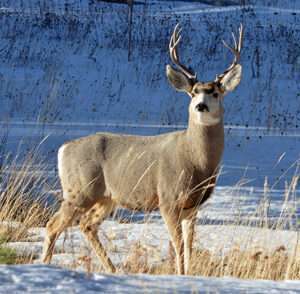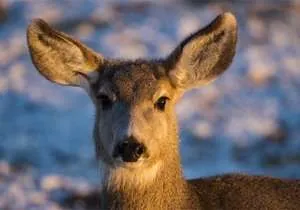Contact: Brendan Lynch, KU News Service, 785-864-8855, blynch@ku.edu, @BrendanMLynch

LAWRENCE — For at least a century, ecologists have wondered at the tendency for populations of different species to cycle up and down in steady, rhythmic patterns.
“These cycles can be really exaggerated — really huge booms and huge busts — and quite regular,” said Daniel Reuman, professor of ecology & evolutionary biology at the University of Kansas and senior scientist at the Kansas Biological Survey. “It attracted people’s attention because it was kind of mysterious. Why would such a big thing be happening?”
A second observation in animal populations might be even harder to fathom: Far-flung communities of species, sometimes separated by hundreds of miles, often fluctuate in synchrony with one another — an effect known as “spatial synchrony.”
Now, Reuman and colleagues have written a new study in the peer-reviewed journal Ecology Letters showing these two effects to be linked, but not in the way that could be expected. By parsing data on weather, deer populations and deer-vehicle collisions in Wisconsin, the investigators show spatial synchrony could be driving population cycles, rather than the reverse.
Reuman compared the linked population phenomena to a famous physics experiment where two grandfather clocks are placed next to each other against a wall.
“Over time, the pendulums become synchronized,” he said. “The reason is because both produce tiny vibrations in the wall. And the vibrations from one of them in the wall influences the other one just a little bit — enough to get the pendulums to eventually become synchronous. One reason people think these cycling populations are easy to synchronize is if a few individuals can get from one to the other, like vibrations that go through the wall for the grandfather clocks. It’s enough to bring these cycling populations into synchrony. That’s how people thought about things before we started our work with this paper.”
But Reuman and his co-authors describe this process can actually go the other way around. The researchers found weather patterns driven by El Nino influenced predictable fluctuations in deer populations across the state as well as synchrony between different deer populations.
Looking at datasets on local temperature and snowfall variations across the state, the team averaged them out, finding “buried underneath all of that randomness a hardly noticeable, but synchronous fluctuation,” Reuman said.
The three-to-seven-year weather fluctuation directly influenced synchronous population cycles in the state’s deer.
“All that local variation would cancel out because it might be a little bit warmer in one place, a little bit colder and another place — but that overall synchronous component, which is related to El Nino in this case, reinforces all the local variation,” Reuman said. “And it’s the same years with deer. So, the reason why the synchrony is causing the cycling is because the synchrony is occurring only on the relevant timescales of the fluctuation. It’s only that component of the three-to-seven-year oscillations that synchronize. All the faster and slower oscillations are all local variation that cancels out when you average across the whole state.”
Moreover, the researchers found these deer population fluctuations predicted the numbers of car collisions with deer statewide more than traffic volume or other factors.
“It was a surprise to us when we figured out that that’s what was going on,” Reuman said. “What it amounts to is a new mechanism for these major population cycles and a new way that they can come about. That’s fundamentally different from the old way that people were thinking about it.”
Lead author Tom Anderson, assistant professor at Southern Illinois University Edwardsville, said the work shows it’s “still possible to discover new information about well-studied scientific phenomena.”
“Researchers have been examining population cycles for more than 100 years, yet our study still uncovered new information,” Anderson said. “That is partly what makes science, and this project in particular, exciting, to be able to uncover new ways of thinking about something that others have thought about extensively. Our work also has important implications in a variety of other areas, including how fluctuations in populations of plants or animals will respond to climate change and that organisms that are economically and socially important to humans, like white-tailed deer, can undergo periods of high and low abundance due to naturally occurring processes across large spatial scales, which might have implications for their subsequent management.”
According to co-author Lawrence Sheppard, postdoctoral researcher with the KU Department of Ecology & Evolutionary Biology and the Kansas Biological Survey, the unexpected relationship between spatial synchrony and population cycles was revealed by “new methods to study the different timescales of change in an ecosystem.”
“We trace how particular timescales of change arise in the data and are communicated from one part of the system to another using ‘wavelets,’ which I first learned to apply to biomedical data during my Ph.D.,” Sheppard said. “In particular, here we find that spatial synchrony on a particular timescale arises from an association with winter climate on that timescale, and the spatial synchrony in the deer population has a substantial statewide impact on human interactions with the deer.”
Additional authors were Jonathan Walter of KU and the University of Virginia and Robert Rolley of the Wisconsin Department of Natural Resources.
Reuman said the findings could transfer to a wide range of other species and ecological systems, with ramifications for agriculture, fisheries, transportation managers and the insurance industry.
“We started out trying to understand the nature of synchrony in these things and trying to figure out what was causing it, and what its consequences are,” Reuman said. “It’s turned out to be related to these overall climatic indices. Now for deer, basically it’s bad winter weather that we’re talking about that synchronizes things. For another particular species, the nature of their relationship with the weather in a location is going to make the difference.”




